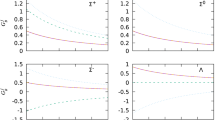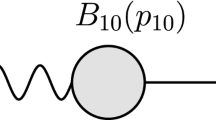Abstract.
The quantum group \( SU_{q}(3) = U_{q}(su(3))\) is taken as a baryon flavor symmetry. Accounting for electromagnetic contributions to baryons masses up to zeroth order, new charge specific q-deformed octet and decuplet baryon mass formulas are obtained. These new mass relations have errors of only 0.02% and 0.08%, respectively, a factor of 20 reduction compared to the standard Gell-Mann-Okubo mass formulas. A new relation between the octet and decuplet baryon masses that is accurate to 1.2% is derived. An explicit formula for the Cabibbo angle, taken to be \(\frac{\pi}{14}\), in terms of the deformation parameter q and spin parity JP of the baryons is obtained.
Similar content being viewed by others
Change history
28 January 2019
After publication of the paper, the author noticed that the acknowledgement section contained an error. The correction is given in this erratum.
28 January 2019
After publication of the paper, the author noticed that the acknowledgement section contained an error. The correction is given in this erratum.
References
A.M. Gavrilik, N.Z. Iorgov, Quantum groups as flavor symmetries: account of nonpolynomial SU(3)-breaking effects in baryon masses, arXiv:hep-ph/9807559 (1998)
A.M. Gavrilik, Nucl. Phys. B Proc. Suppl. 102, 298 (2001)
A.M. Gavrilik, Quantum groups in hadron phenomenology, arXiv:hep-ph/9712411 (1997)
G. Morpurgo, Phys. Rev. D 45, 1686 (1992)
G. Morpurgo, Phys. Rev. Lett. 68, 139 (1992)
G. Dillon, G. Morpurgo, Phys. Lett. B 481, 239 (2000)
Michio Jimbo, Lett. Math. Phys. 10, 63 (1985)
V.G. Drinfeld, Sov. Math. Dokl. 32, 254 (1985)
M. Jimbo, Lett. Math. Phys. 10, 63 (1985)
R.J. Finkelstein, On q-Electroweak arXiv:hep-th/0110075 (2001)
Robert J. Finkelstein, An $SLq(2)$ Extension of the Standard Model, arXiv:1205.1026 (2012)
Harold Steinacker, Commun. Math. Phys. 192, 687 (1998)
Daniel Sternheimer, The geometry of space-time and its deformations from a physical perspective, in From Geometry to Quantum Mechanics (Springer, 2007) pp. 287--301
Shahn Majid, Henri Ruegg, Phys. Lett. B 334, 348 (1994)
Jerzy Lukierski, Anatol Nowicki, Int. J. Mod. Phys. A 18, 7 (2003)
Leonardo Castellani, Julius Wess, Quantum Groups and Their Applications in Physics, Vol. 127 (IOS Press, 1996)
A.M. Gavrilik, Quantum algebras, particle phenomenology, and (quasi) supersymmetry, arXiv:hep-ph/0402082 (2004)
A Carcamo, The Gell-Mann-Okubo and Colemann-Glashow relations for octet and decuplet baryons in the $SU_q (3)$ quantum algebra, arXiv:hep-ph/0511202 (2005)
Murray Gell-Mann, The eightfold way: A theory of strong interaction symmetry, Technical report (California Inst. of Tech., Pasadena Synchrotron Lab., 1961)
Susumu Okubo, Prog. Theor. Phys. 27, 949 (1962)
S. Okubo, Phys. Lett. 4, 14 (1963)
G. Morpurgo, Phys. Rev. D 40, 2997 (1989)
Alexandre Gavrilik, Can the Cabibbo mixing originate from noncommutative extra dimensions? in Noncommutative Structures in Mathematics and Physics (Springer, 2001) pp. 343--355
R. Jaganathan, Some introductory notes on quantum groups, quantum algebras, and their applications, arXiv:math-ph/0105002 (2001)
Christiane Quesne, J. Phys. A: Math. Gen. 25, 5977 (1992)
Harold Steinacker, Commun. Math. Phys. 192, 687 (1998)
A.M. Gavrilik, I.I. Kachurik, A.V. Tertychnyj, Representations of the $Uq(u(4,1))$ and a q-polynomial that determines baryon mass sum rules, arXiv:hep-ph/9504233 (1995)
Keith A. Olive, Particle Data Group et al., Chin. Phys. C 38, 090001 (2014)
M. Gerstenhaber, Ann. Math. 79, 59 (1964)
A. Nijenhuis, R.W. Richardson, J. Math. Mech. 17, 89 (1967)
R.V. Mendes, J. Phys. A: Math. Gen. 27, 8091 (1994)
D.V. Ahluwalia, N.G. Gresnigt, A.B. Nielsen, D. Schritt, T.F. Watson, Int. J. Mod. Phys. D 17, 495 (2008)
C. Chryssomalakos, E. Okon, Int. J. Mod. Phys. D 13, 2003 (2004) arXiv:hep-th/0407080
N.G. Gresnigt, P.F. Renaud, P.H. Butler, Int. J. Mod. Phys. D 16, 1519 (2007) arXiv:hep-th/0611034
Robert J. Finkelstein, Int. J. Mod. Phys. A 20, 6487 (2005)
Robert J. Finkelstein, Int. J. Mod. Phys. A 22, 4467 (2007)
N.G. Gresnigt, A.B. Gillard, Electroweak symmetries from the topology of deformed spacetime with minimal length scale, arXiv:1512.04339 (2015)
Daniel Sternheimer, “The important thing is not to stop questioning”, including the symmetries on which is based the standard model, in Geometric Methods in Physics (Springer, 2014) pp. 7--37
Moshe Flato, Czech. J. Phys. 32, 472 (1982)
Philippe Bonneau, Daniel Sternheimer, Topological Hopf algebras, quantum groups and deformation quantization, arXiv:math/0307277 (2003)
Author information
Authors and Affiliations
Corresponding author
Additional information
Communicated by S. Hands
Rights and permissions
About this article
Cite this article
Gresnigt, N. Charge specific baryon mass relations with deformed SUq(3) flavor symmetry. Eur. Phys. J. A 52, 321 (2016). https://doi.org/10.1140/epja/i2016-16321-9
Received:
Accepted:
Published:
DOI: https://doi.org/10.1140/epja/i2016-16321-9




